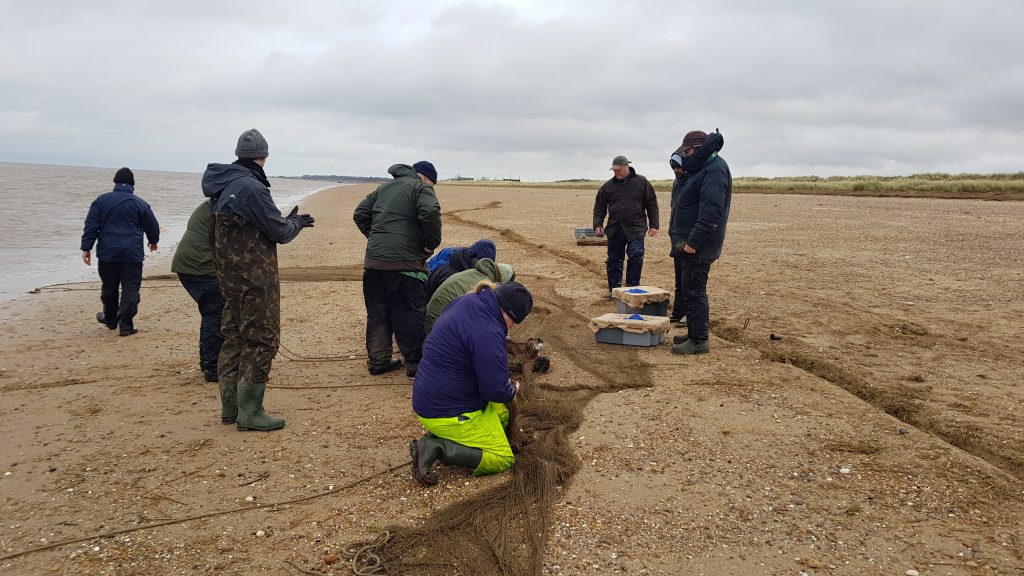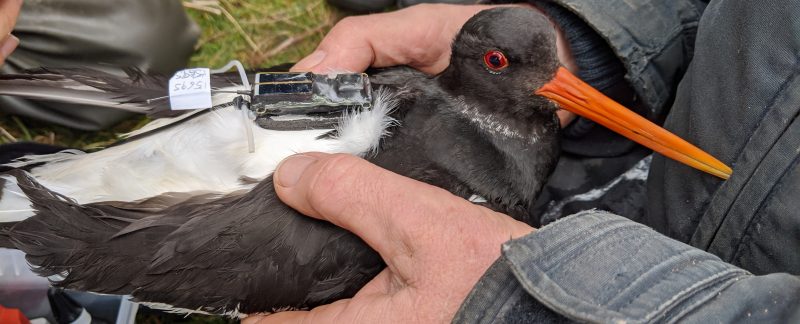Weather forecast:
Storm Dennis!
Saturday – strong winds with showers
Sunday – strong winds with rain
Recce and plan for the weekend
The plan for the weekend was for a cannon-net catch on either Saturday or Sunday morning depending on the findings of the recce team on Friday morning. One of the aims for the weekend was a trial for catching waders on a non-spring tide – the tide heights were considerably lower than those for a normal catching weekend. Mist netting was not an option for the weekend due to the tide heights.
As the team anxiously looked at the weather forecasts as the weekend (and Storm Dennis) approached it became apparent that, yet again, the weather gods were not on our side. However, it is definitely not in the spirit of WWRG to be thwarted by mere storms and the weekend planning continued.
Jen and Mark undertook recces of the beaches at Snettisham, Heacham South and Heacham North North at high tide on Friday 14 February, with Mark on Snettisham Beach at 07:00 and Jen on Heacham South at the same time. Despite good numbers of birds out on the exposed mud at Snettisham, no birds came onto the beach as the tide rose. However, on Heacham beach, Jen had a pre-roost of Oystercatchers which moved up the beach with the tide, forming a roost of approximately 1,000 Oystercatchers along with 300 or so grey waders, mainly Bar-tailed Godwit. Both Jen and Mark then moved to Heacham NN beach where they found a settled flock of Oystercatchers in a high tide roost with 20−30 grey waders.
Friday 14 February
Cathy also arrived early on Friday and made a good start on collecting data for the weekend by resighting a total of 18 birds on Heacham NN beach with a mixture of Curlew, Bar-tailed Godwit and Turnstone.
Most of the team arrived on Friday evening and were greeted by Ron’s signature dish of jacket potatoes and vegetables with apple crumble for pudding – always a great start to a Wash weekend. Rumours of a 03:30 start were spreading, soon to be confirmed in a briefing by Ryan, one of the WWRG cannon net trainees. Due to the time of high tide, it was necessary to set the cannon nets very early on Saturday morning, setting in the dark in order to be off the beach several hours before the first birds move up the beach, hopefully preventing any disturbance to the birds. The target for the morning was the Oystercatcher flock on Heacham South beach where markers had been left the previous day by Mark. The plan was to set two narrow, large-mesh nets and to catch the birds on the incoming tide as they moved up the beach, in a similar way to the evening catch in January.
A curfew of 22:30 was set to enable the team to get some sleep before the 03:30 alarms.
Saturday 15 February
The team was up and ready to leave on time. Just as Nigel was about to drive out of the car park, someone noticed that one of the trailer tyres was flat causing a few choice remarks and a short delay to leaving. Once at Snettisham, there was another short delay whilst the markers were located in the dark (always tricky when markers which appear to be clear as anything in daylight become impossible to locate as one bush looks similar to another in the dark). Despite these hitches an efficient set resulted in the team being off the beach by 06:04 – a mere four minutes behind schedule. There followed a long wait for the first glimmers of daylight when the firing teams headed for the beach and the longstops got into position to discourage dog walkers from disturbance on the beach.
The tide was still way out with birds spread out across the mud. After a long wait, a pre-roost of Oystercatchers began to gather but unfortunately these had positioned themselves 20 yards south of the nets. Chantal was sent to walk across the mud to gently encourage the flock to move north but, Oystercatchers being Oystercatchers, the flock flew south towards Snettisham instead. All was not lost as the tide was still quite a way out at this time and a second roost began to form as birds flew south from Heacham. The birds began to move up the beach in a triangular formation and began to look quite promising, although the birds were quite unsettled.
Unfortunately, a small group of Turnstones chose this moment to arrive along the grot line and began to systematically move towards the net. Without the Turnstones the catch could have been delayed, allowing the Oystercatchers to move further up the beach to maximise the catch but, with a possible 50−60 birds in the catching area, the decision was made to fire the net. Unfortunately, the net failed to go out as far as it should have done and only a small catch of 12 Oystercatchers was made. Initially, the problem seemed to be that the strong wind had prevented the net going out but, once the equipment was taken up, it became clear that one of the four cannons had failed to fire. There was some disappointment within the team although three new members to the group were able to ring their first waders (two of whom had never ringed any birds before).

The small catch also allowed Ryan to train a couple of experienced team members on attaching leg loop harnesses to large waders. This was of interest to many people, most of whom had never had the opportunity see this in practice. The harnesses were only used for training and were removed from the birds before they were released.
Meanwhile, the Heacham NN roost seen by Jen and Mark on the previous morning remained tantalisingly in a catchable position all morning but any thoughts of trying for these on Sunday morning were squashed by the weather forecast.
Catch totals
| Species | New | Re-trap | Total |
| Oystercatcher | 9 | 3 | 12 |
| Species | Adult (8) | Immature (6i/8i) | Juvenile (5) |
| Oystercatcher | 10 | 2 | 0 |
The team returned to the base house for breakfast and some people then decided to leave for home for various reasons, with a core team of nine people remaining. A very productive afternoon was spent with six people working on the data from the 2019 catches and others doing a variety of tasks including planning, and shopping for, the evening meal. David spent the afternoon towing cars out of the extremely muddy car park area, where they had become stuck. He eventually returned to the house absolutely caked in mud from head to toe but with some very grateful drivers!
Despite the forecast for more wind and rain in the morning, the team decided that there was a window for resighting on Sunday and plans were therefore made. Chantal, with help from others, masterminded a delicious evening meal whilst the data checkers continued with their tasks.
Sunday 16 February
There was a leisurely start to the day as rain was forecast until around 10:00 so resighting was planned around the high tide period in a fairly short window in the weather. Four groups went out to explore the newly created wetlands on Ken Hill, both to estimate numbers of Curlew using the area and to look for flags if birds were within reading range. Good numbers of Black-tailed Godwit and Curlew have been seen in this area but always too far to read any flags from the seawall. The group has obtained permissions for access so it was a good opportunity for an exploration of the possibilities. Jenny and Kate found a flock of 59 Curlew between the seawall and Heacham South beach with a total of nine flagged birds amongst them. The rain began again in earnest just as people returned to their cars.
In a search for undiscovered flocks of wintering Curlew, Bernard joined the team on Sunday morning and explored the areas around Wolferton, Castle Rising and North Wootton. He found the grand total of one Curlew which was however flagged! This Curlew is presumed to be from a German scheme (with one ring missing) and was seen previously in the exact same place at Wolferton.
On return to the base, the building was cleaned and tidied before most people left on their homeward journeys whilst two enthusiasts headed for Heacham NN taking advantage of the improvement in the weather (and shorter homeward journeys) to make a final push on the resighting totals for the weekend.
Resighting totals for the weekend:
| Species | Sightings | Individuals | WWRG | Non-WWRG |
| Curlew | 27 | 27 | 26 | 1 |
| Bar-tailed Godwit | 13 | 10 | 9 | 1 |
| Black-tailed Godwit | 2 | 2 | 0 | 2 |
| Turnstone | 9 | 8 | 8 | 0 |
| Knot | 1 | 1 | 0 | 1 |
| Total | 52 | 48 | 43 | 5 |
In the table, ‘sightings’ refers to an individual bird present at a particular time which may have been seen by one or more people. Information already received regarding the non-WWRG marked birds is as follows:
One of the Black-tailed Godwits was ringed as a first winter bird on 6 November 2018 at Welwick Saltmarsh Pools on the north bank of the Humber Estuary. The second Black-tailed Godwit is one of Jenny Gill’s birds ringed in Norfolk, identified by a white scheme marker on the right tarsus.
The Knot was ringed in Norway in May 2019, the second Norwegian marked bird to be found by WWRG this year.
The Bar-tailed Godwit has been seen regularly at Snettisham for several years, also ringed in Norway.
Thanks to everyone involved for their hard work and good company over the weekend. We have one remaining weekend of winter fieldwork – let’s hope for some good weather for this!

